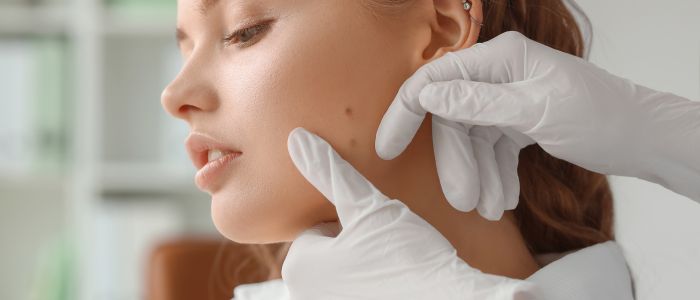
Table of Contents
- Important Steps for Optimal Recovery after Mole Removal
- Why Mole Removal Is Necessary?
- The Mole Removal Process
- What to Expect Immediately After Mole Removal?
- Essential Steps for Successful Recovery after Mole Removal
- Tips for Minimising Scarring Post Mole Removal
- Potential Complications and How to Handle Them
- Follow-Up Care and Maintaining Skin Health Post Mole Removal
- When to Seek Medical Attention after Mole Removal?
- FAQs about Recovery after Mole Removal
- Further Reading about Procedures at Cheshire Cosmetic Surgery
Important Steps for Optimal Recovery after Mole Removal
You’ve probably seen a mole somewhere on your body. These small, dark spots on the skin can be harmless, but sometimes they may pose a health risk. That’s when the concept of mole removal comes into the picture. Mole removal is a common procedure performed by plastic surgeons worldwide. It involves the surgical extraction of the mole, either for cosmetic reasons or because the mole is potentially dangerous. It might seem like a simple process, but it’s important to understand what it entails and how is the recovery after mole removal.
A proper recovery process after mole removal ensures that the skin heals well, minimises the chances of infection, and reduces the likelihood of scarring. In this blog, Chester Consultant Plastic Surgeon Anca Breahna will provide you with all the necessary information for a successful recovery after mole removal.
Why Mole Removal Is Necessary?
Mole removal may be necessary for several reasons. One of the most common reasons is cosmetic preference. You might decide to have a mole removed because you find it unattractive or it’s in a location that causes discomfort, such as where your clothes rub against it.
In some cases, mole removal is medically necessary. Some moles can develop into skin cancer, specifically malignant melanoma, which is a very serious and potentially deadly form of skin cancer. If a mole changes in size, colour, shape, or texture, it’s essential to have it checked by a doctor. Early detection and removal of cancerous moles can significantly increase the chances of successful treatment and recovery.
Even if a mole isn’t cancerous, it might be pre-cancerous. This means that while the mole isn’t currently cancerous, it has the potential to become so in the future. Doctors can identify pre-cancerous moles and often recommend their removal as a precautionary measure.
The Mole Removal Process
The process of mole removal is relatively straightforward. After numbing the area, Anca will use a scalpel to cut the mole and a small amount of surrounding tissue. If the mole is large or deep, stitches may be necessary. Alternatively, if the mole is small and close to the skin’s surface, it may be removed using a technique known as shave excision, where the mole is “shaved” off the skin’s surface.
Laser mole removal is another popular method. In this procedure, a concentrated beam of light is used to break down the mole. It’s a less invasive method, but it might not be suitable for larger or deeper moles. Another option is cryotherapy, where the mole is frozen off using a substance like liquid nitrogen. This method is often used for smaller, superficial moles.
Regardless of the removal method, the goal is to remove the mole completely and minimise any scarring. After the mole has been removed, it’s usually sent to a lab for analysis. This step is especially important if the mole was removed due to the risk of cancer.
What to Expect Immediately After Mole Removal?
Immediately following a mole removal procedure, it is common to experience a range of sensations and changes in the treated area. Here’s a more detailed look at what you can expect:
- Immediate Post-Procedure Symptoms: Right after the mole is removed, it’s typical to feel some discomfort or pain in the area. This is a natural response of your body to the minor trauma of the procedure. Along with discomfort, you might notice swelling and redness around the site. These symptoms are part of the normal inflammatory response as your body begins the healing process
- Tenderness and Bleeding: The area where the mole was removed may be tender to the touch. This tenderness should gradually decrease over the next few days. A small amount of bleeding or oozing is also common, especially in the first few hours post-procedure. This is usually nothing to worry about, but if you notice excessive bleeding, it’s important to contact Anca’s team
- Bandaging and Wound Care: Anca will likely apply a sterile bandage to the area to protect the wound and promote healing. It’s important to keep this bandage clean and dry to reduce the risk of infection. You’ll be given specific instructions on how to care for the wound, including how often to change the bandage
- Activity Restrictions: In the days following the mole removal, it’s advised to take it easy. Avoid strenuous activities, heavy lifting, or any exercise that might stretch or stress the skin around the wound. This precaution helps to prevent reopening the wound and ensures a smoother healing process
- Medications and Ointments: Anca may prescribe or recommend an antibiotic ointment to apply to the area to prevent infection. Additionally, over-the-counter pain relievers or prescribed medications might be suggested to manage any discomfort
- Monitoring for Infection: While infections are not common, it’s important to be aware of the signs. If you notice increased redness, swelling, warmth, or a discharge that is yellow or green, contact your healthcare provider. Fever or worsening pain can also be signs of an infection
Essential Steps for Successful Recovery after Mole Removal
Successful recovery after mole removal depends on a few key steps. First and foremost, follow Anca’s advice. She will provide detailed information on what to do and what to avoid during the recovery phase. This might include avoiding certain activities, using specific skincare products, or taking prescribed medications.
Keep the wound clean and dry. This is important to prevent infection. You might need to change the bandage daily and apply an antibiotic ointment. Avoid picking at the wound or removing the stitches (if you have them) on your own. These actions can slow down the healing process and increase the risk of scarring.
Protect the area from the sun. The newly healed skin will be more sensitive to sunlight, and sun exposure can increase the risk of scarring and discoloration. When you’re outside, wear a broad-spectrum sunscreen with an SPF of 50 or higher.
Tips for Minimising Scarring Post Mole Removal
While some degree of scarring is inevitable after mole removal, there are ways to minimise it. One of the most important is to avoid sun exposure. The sun’s UV rays can darken the scar and make it more noticeable. Always apply sunscreen to the area, even if it’s not directly exposed to the sun.
Another tip is to moisturise the area regularly. Keeping the skin hydrated can help it heal better and reduce the appearance of scars. Use a hypoallergenic, non-comedogenic moisturiser to prevent skin irritation.
Gentle massage can also help reduce scarring. Once the wound has fully healed, you can gently massage the area with a moisturiser or a silicone-based scar gel. This helps to break down the scar tissue and improve the skin’s appearance.
Potential Complications and How to Handle Them
While mole removal is a safe procedure, there can be potential complications. These might include infection, an allergic reaction to the anaesthetic, or the mole growing back.
If you notice any signs of infection, such as increased redness, swelling, pus, or a fever, contact your doctor immediately. An untreated infection can lead to more serious complications.
If the mole grows back, it doesn’t necessarily mean that it’s cancerous. However, it’s important to have it checked by a doctor. In some cases, a second procedure might be necessary to remove the mole completely.
Follow-Up Care and Maintaining Skin Health Post Mole Removal
Follow-up care after mole removal is essential. Anca will want to check the wound to ensure it is healing properly and that there are no signs of infection. She might also want to discuss the results of the mole analysis with you.
Maintaining skin health post mole removal involves continuing to protect the skin from the sun and keeping it moisturised. It’s also important to check your skin regularly for any new or changing moles.
If you notice any unusual skin changes or if you’re concerned about a mole, it’s always better to seek medical advice. Early detection and treatment of skin cancer significantly increase the chances of a successful outcome.
When to Seek Medical Attention after Mole Removal?
You should seek medical attention after mole removal if you notice any signs of infection or if the wound isn’t healing as expected. This includes excessive pain, redness, swelling, pus, or a fever. If the mole grows back or if you notice any new or changing moles, it’s also important to get them checked by a doctor.
It’s normal to feel anxious after mole removal, especially if the mole was removed due to a risk of cancer. However, remember that the vast majority of mole removal procedures are successful, and complications are relatively rare. With proper care and attention, you can expect a smooth recovery and healthy skin.
FAQs about Recovery after Mole Removal

How long does it typically take for the wound to heal after mole removal?
The healing time can vary depending on the method of removal and individual factors like overall health and age. Generally, it takes about 2 to 4 weeks for the wound to heal significantly.
Can I shower or bathe normally after mole removal?
You can usually shower after the procedure, but it’s important to avoid directly soaking the treated area for the first 24 to 48 hours. Gently pat the area dry after getting it wet.
Is it normal to have a scar after mole removal?
Scarring can occur, but its extent varies depending on the mole removal technique used and individual healing characteristics. Most scars fade and become less noticeable over time.
When can I return to my regular skincare routine?
You should wait until the wound has completely healed before resuming your regular skincare routine. This means waiting until any scabs have fallen off naturally, which can take a few weeks.
Can I apply makeup over the mole removal site?
It’s best to avoid applying makeup directly on the wound until it has fully healed to prevent infection and irritation. Once healed, makeup can usually be applied as normal.
When is it safe to start exercising again after mole removal?
Light exercise can often be resumed a few days after the procedure, but it’s best to avoid strenuous activities or exercises that stretch the skin near the removal site for at least 1-2 weeks.
How can I minimise scarring after mole removal?
Keeping the area clean, protected from the sun, and moisturised can help minimise scarring. Additionally, avoid picking at scabs and follow Anca’s instructions for wound care.
Medical References about Mole Removal
- Moles – Diagnosis and treatment – Mayo Clinic
- Mole Removal: Surgery, Aftercare & Scars – Cleveland Clinic
- Moles – NHS
- Mole Removal: What to Expect and Aftercare – Cancer Center
- Mole removal scar: Healing and treatments – Medical News Today
Further Reading about Procedures at Cheshire Cosmetic Surgery
- Read more about Skin Mole Removal
- Read more about Mole / Cyst / Wart / Skin Tag Excision
- Read more about The Mole Guide
- Read more about Skin Cancer & Mole Surgery At Chester Cosmetic Surgery
- Read more about Why You Should See a Plastic Surgeon for Minor Skin Surgery, Lumps and Bumps







